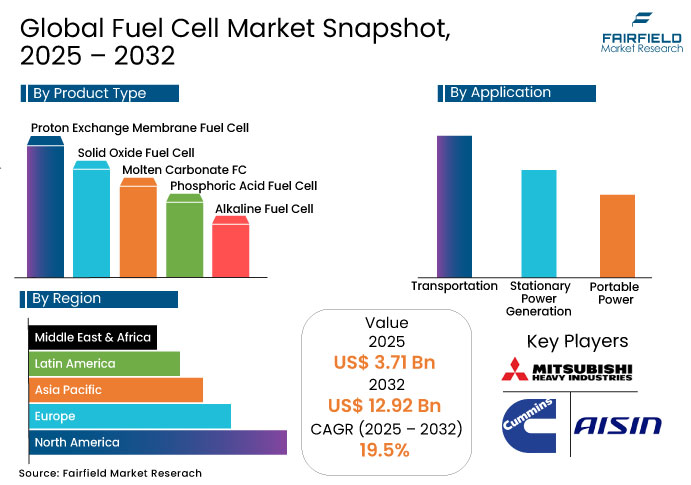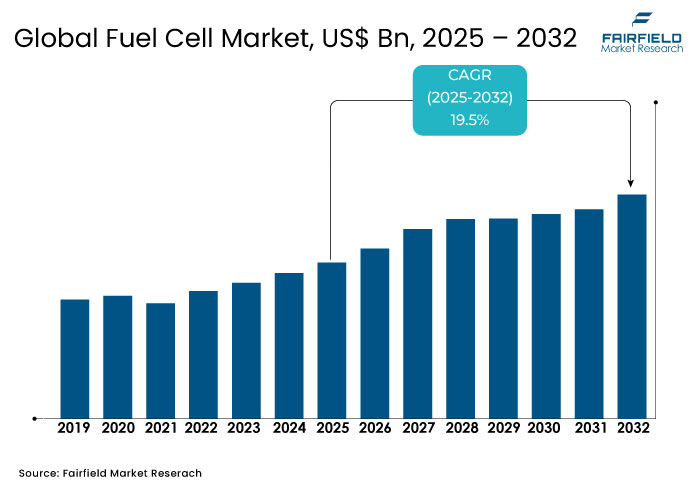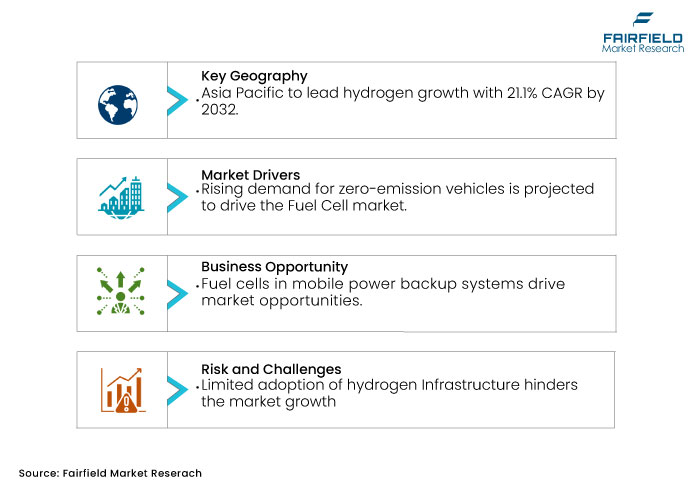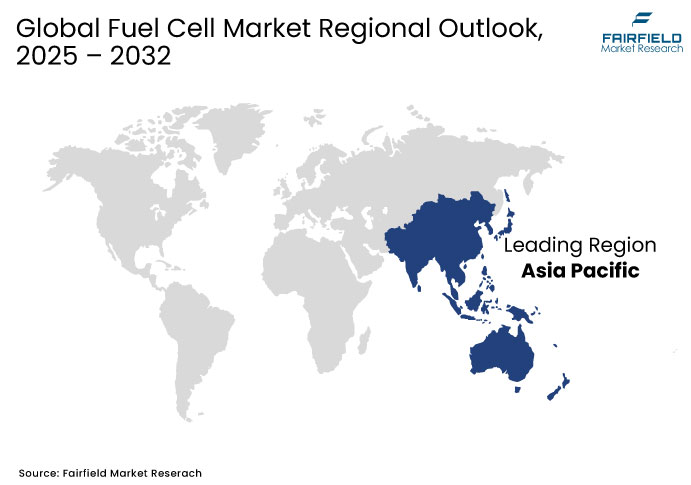Global Fuel Cell Market Forecast
- The global Fuel Cell market size is projected to witness a CAGR of 19.5% during the forecast period from 2024 to 2031. It is anticipated to increase from US$ 3.71 Bn recorded in 2025 to a staggering US$ 12.92 Bn by 2032.
- Rising demand for electric vehicles (EVs) and robust governmental support for clean energy initiatives drive the global fuel cell market. Global initiatives to reduce the carbon footprint are enticing several industries towards the use of fuel cells.

Fuel Cell Market Insights
- Rising demand for zero-emission vehicles is projected to drive the Fuel Cell market.
- Increasing regulatory pressures and commitments to reduce carbon emissions, particularly in regions such as the European Union (EU) and the United States are leading the Fuel Cell market.
- The emerging applications of fuel cells in mobile power backup systems create many opportunities for the fuel cell market.
- In terms of product type, the proton exchange membrane fuel cell is anticipated to witness a CAGR of 20.1% by 2032, with high demand from the transportation sector.
- Based on applications, the transportation segment is projected to showcase a CAGR of 20.0% through 2032.
- In North America, the U.S. is estimated to dominate with a CAGR of 19.7% through 2032.
- The European fuel cell market holds around 16% share of the global market due to the favorable conditions of the European Union.
- Asia Pacific is anticipated to capture the highest CAGR of 21.1% by 2032 amid favorable government policies and rising interest in hydrogen production.
A Look Back and a Look Forward- Comparative Analysis
The global fuel cell industry experienced an annual decline of 5.8% from 2019 to 2024, driven by disruptions such as the COVID-19 pandemic and the Russia-Ukraine conflict. Technological limitations also restrained market growth until 2022. However, the industry is now gaining momentum, particularly in logistics and freight transport, where demand for sustainable, low-emission solutions continues to rise.
Fuel cell vehicles (FCVs) are becoming the preferred option for long-haul operations, offering zero emissions, longer ranges, and faster refueling compared to battery electric vehicles. Expanding hydrogen infrastructure, supported by government incentives is accelerating FCV adoption across logistics fleets. Ongoing technological advancements are lowering production costs, enhancing the appeal of fuel cells to businesses committed to greener practices. As companies strive to meet tightening regulatory standards and growing consumer expectations for sustainability, fuel cells are reshaping the logistics and freight sectors, positioning the market for a strong rebound and sustained growth.
Key Growth Determinants
Rising Demand for Zero Emission Vehicles
The global fuel cell market is witnessing strong growth, fueled by the rising adoption of electric vehicles (EVs) and increased governmental support for clean energy initiatives. The International Energy Agency (IEA) projects that electric car sales will account for over 20% of total car sales in 2024, with initiatives such as the EV20@30 campaign aiming for at least 30% new EV sales by 2030.
Countries including Canada, Japan, France, and Norway are actively expanding EV deployment, recognizing its pivotal role in carbon reduction efforts. Heightened competition among automakers is driving innovation, reducing battery costs, and improving vehicle affordability. As fuel cells become integral to next-generation EV technologies, their role in advancing sustainable energy systems is growing significantly. Further propelling the market, Ballard Power Systems plans to unveil its high-performance FCmove®-XD fuel cell engine in 2024, featuring the first public demonstration of its 240kW configuration.

Key Growth Barriers
Limited Adoption of Hydrogen Infrastructure
The fuel cell market faces significant constraints, particularly due to the limited adoption of hydrogen in emerging applications. While the U.S. Department of Energy has invested $7 billion in clean hydrogen hubs, most hydrogen production still supports traditional sectors like refining and chemicals, which depend heavily on unabated fossil fuels. This reliance undermines the environmental advantages of hydrogen, hindering its potential to contribute to carbon neutrality.
In Europe, the Fuel Cells and Hydrogen Joint Undertaking forecasts that hydrogen could supply around 25% of the region’s total energy consumption by 2050. However, achieving this vision depends on overcoming infrastructure challenges and broadening the use of hydrogen technologies beyond established applications. Currently, sectors such as heavy industry and transport account for less than 0.1% of global hydrogen demand, revealing a significant gap. Expanding hydrogen's role in these areas is essential for unlocking its full potential and driving meaningful market growth.
Fuel Cell Market Trends and Opportunities
Regulatory Pressures and Environmental Commitments Driving the Market
The transition toward a circular economy is accelerating as companies prioritize waste-derived feedstocks and invest in advanced technologies such as gasification and anaerobic digestion. In April 2024, Shell launched Germany’s largest bio-LNG plant at its Energy and Chemicals Park Rheinland, producing up to 100,000 tons annually using fuel cells from the gas grid and aiming to cut CO₂ emissions by up to one million tons per year.
Furthermore, in March 2025, Gasum partnered with Fazer to convert inedible bakery waste into biogas, powering part of Fazer’s transportation fleet and supporting its carbon reduction objectives. In 2024, Air Liquide expanded its fuel cell production in the U.S. with two new units utilizing dairy farm waste. These advancements are reinforced by initiatives such as Air Liquide’s sustainability charter, which promotes stronger environmental practices and accelerates the integration of renewable feedstocks into modern energy systems.
Growth in Fuel Cell Application Beyond Transportation
The fuel cell market is unlocking significant growth opportunities, particularly in mobile applications. Beyond traditional roles such as telecommunications backup, demand is rising for large mobile systems tailored for events and construction. According to ERM, these systems now feature mobility enhancements such as wheels and lift hoists, expanding their use beyond stationary deployments.
Although high hydrogen costs and logistical challenges persist, the increasing focus on portable solutions signals a technology-driven market shift. Shipments of portable fuel cells, including auxiliary power units (APUs) under 20 kW, grew from over 6,000 units in 2021 to nearly 8,000 in 2022, highlighting broader adoption. Industrial and consumer markets in Europe and North America are leading this expansion, driving innovation and efficiency improvements. As industry stakeholders prioritize adaptable and versatile solutions, mobile applications are emerging as a critical growth driver, positioning the fuel cell sector for broader market expansion in the years ahead.

Leading Segment Overview
Proton Exchange Membrane Fuel Cell Leads the Market due to its Multiple Benefits
Proton exchange membrane (PEM) fuel cells are poised to dominate the market, projected to achieve a strong CAGR of approximately 20.1% and capture nearly 90% of the fuel cell market share. Their growing demand is driven by key advantages, including flexibility in input fuel, compact and lightweight design, cost-effectiveness, and a durable electrolyte. These features position PEM fuel cells as the preferred choice over alternative technologies, reinforcing their market leadership.
Furthermore, Plug Power in 2024 launched the technical evaluation phase for a 25 MW PEM electrolyzer project in partnership with Dourogás and CapWatt. Aimed at producing 80,000 tons of methanol annually, the project demonstrates the increasing adoption of PEM technology and its expanding role in supporting large-scale energy and chemical production initiatives.
Transportation Sector Heavily Demands the Fuel Cell
The transportation segment leads the fuel cell market, accounting for approximately 75% of the total share, driven by the global shift toward clean transport solutions. Growing investments in emission-free initiatives across various countries are further strengthening this segment. Fuel cells offer broad applications, from material handling that improves warehouse and manufacturing efficiency to e-mobility solutions powering delivery fleets, airport operations, long-haul trucks, and maritime activities.
In 2023, Doosan Fuel Cell partnered with Kolon Global to develop a hydrogen fuel cell business model utilizing biogas. Under this collaboration, Doosan Fuel Cell is responsible for hydrogen fuel cell supply and long-term service agreements (LTSA), while Kolon Global manages fuel supply, EPC, and the development of piping infrastructure. Together, they are advancing the deployment of eco-friendly energy solutions and reinforcing the growing role of fuel cells in sustainable transportation.
Regional Analysis
- Government Initiatives and Industrial Advancements Drives the North American Market
North America remains a critical growth hub for the global fuel cell market, supported by strong government initiatives, technological advancements, and rising investments in clean energy infrastructure. The United States leads regional growth, driven by the Inflation Reduction Act (IRA) and significant funding for hydrogen and fuel cell projects aimed at decarbonizing transportation, industrial, and power generation sectors. Canada is also strengthening its position through national hydrogen strategies and partnerships to promote fuel cell adoption across key industries.
Leading companies such as Plug Power, Ballard Power Systems, and Bloom Energy are expanding production capabilities, establishing new manufacturing facilities, and advancing technology to improve efficiency and reduce costs. The region is also witnessing growing demand for fuel cells in heavy-duty transport, backup power systems, and distributed energy solutions. However, regional market expansion remains dependent on the pace of infrastructure development and continued policy support, which are essential to fully unlocking North America's fuel cell potential.

- Driving Sustainability and Innovation in Clean Energy Fuels the European Market
Europe plays a pivotal role in the global fuel cell market, driven by ambitious decarbonization targets, strong regulatory frameworks, and large-scale investments in hydrogen infrastructure. The European Union’s Green Deal and the Hydrogen Strategy for a Climate-Neutral Europe are major catalysts, promoting the adoption of fuel cell technologies across transportation, industrial, and energy sectors. Countries like Germany, France, and the Netherlands are leading the way with national hydrogen plans, funding programs, and pilot projects focused on scaling up fuel cell deployment.
Major players, including Siemens Energy, Alstom, and Bosch, are advancing fuel cell innovation, particularly for mobility applications such as hydrogen trains, heavy-duty trucks, and maritime transport. Europe is also expanding green hydrogen production to support fuel cell systems. While technological progress and public-private collaborations are accelerating market growth, high production costs and infrastructure gaps remain challenges. Stronger cross-border cooperation and continued investment will be crucial for sustaining Europe's leadership in the fuel cell sector.
- Asia-Pacific Leads the Fuel Cell Market as the use of clean energy soars
Asia Pacific dominates the global fuel cell market, holding more than 50% share, with China accounting for over 40% of the region’s market. This leadership is fueled by the rising adoption of electric vehicles (EVs) and strong government backing for clean energy initiatives. According to the International Energy Agency (IEA), global EV sales are expected to reach 17 million in 2024, representing over 20% of total car sales, a 25% increase compared to early 2023.
Regional forecasts show EVs capturing 45% of sales in China, 25% in Europe, and over 11% in the United States, further driving fuel cell demand. Beyond transportation, hydrogen fuel cell technology is also advancing. In 2024, Toshiba Energy Systems and Solutions Corporation secured an order for a 500 kW H2Rex™ pure hydrogen fuel cell system from Tanaka Kikinzoku Kogyo K.K. Scheduled for delivery in March 2026, the system will mark Japan’s largest commercial pure hydrogen fuel cell deployment.
Competitive Landscape
The global fuel cell market is undergoing rapid growth, fueled by continuous innovation and rising investment from both established and emerging players. Companies are advancing fuel cell technologies by enhancing efficiency, durability, and power density, driving strong supply-side momentum. Significant progress in solid oxide fuel cells (SOFCs), proton exchange membrane (PEM) fuel cells, and alkaline fuel cells is reshaping the competitive landscape.
Local players are ramping up investments in hydrogen and fuel cell technologies, while global leaders are partnering with regional providers to boost efficiency and expand their market reach. To meet escalating demand, manufacturers like Plug Power and Bloom Energy are increasing production capacity through new facilities and automation, targeting commercial and industrial sectors. Despite this momentum, market growth remains uneven and heavily influenced by national policies, highlighting the critical need for stronger policy support to accelerate adoption and advance the global transition to sustainable energy systems.
- In May 2024, Mitsubishi Electric Mobility and AISIN reached a Basic Agreement to Establish a Joint Venture Company for Handling Products for Next Generation Electric Vehicles. The JV will offer new and attractive products to a wide range of customers, maximizing the synergy of Mitsubishi Electric Mobility’s traction motors, power converters and control optimization technologies, and AISIN’s integration technology.
- In September 2024, EKPO Fuel Cell Technologies GmbH (EKPO), a leading full-service supplier of PEMFC stack modules and stack components, is focusing its business on hydrogen mobility in the commercial vehicle segment. Delivering up to 400 kW, it is EKPO’s most powerful model yet and has been designed particularly with heavy-duty applications in mind.
Key Market Companies
- AISIN Corporation
- Cummins Inc.
- Mitsubishi Heavy Industries
- Toshiba Corporation
- Fuji Electric Co Ltd
- Bloom Energy
- Plug Power Inc
- Doosan Fuel Cell Ltd
- SFC Energy AG
- FuelCell Energy Inc
- Ballard Power System
- Ceres Power
- Solid Power
Global Fuel Cell Market is Segmented as-
By Product Type
- Proton Exchange Membrane Fuel Cell
- Solid Oxide Fuel Cell
- Molten Carbonate FC
- Phosphoric Acid Fuel Cell
- Alkaline Fuel Cell
- Misc.
By Application
- Stationary Power Generation
- Transportation
- Portable Power
By Region
- North America
- Europe
- Asia Pacific
- Latin America
- The Middle East & Africa
1. Executive Summary
1.1. Global Fuel Cell Market Snapshot
1.2. Future Projections
1.3. Key Market Trends
1.4. Regional Snapshot, by Value, 2025
1.5. Analyst Recommendations
2. Market Overview
2.1. Market Definitions and Segmentations
2.2. Market Dynamics
2.2.1. Drivers
2.2.2. Restraints
2.2.3. Market Opportunities
2.3. Value Chain Analysis
2.4. COVID-19 Impact Analysis
2.5. Porter's Fiver Forces Analysis
2.6. Impact of Russia-Ukraine Conflict
2.7. PESTLE Analysis
2.8. Regulatory Analysis
2.9. Price Trend Analysis
2.9.1. Current Prices and Future Projections, 2024-2032
2.9.2. Price Impact Factors
3. Global Fuel Cell Market Outlook, 2019 - 2032
3.1. Global Fuel Cell Market Outlook, by Product Type, Value (US$ Bn), 2019-2032
3.1.1. Proton Exchange Membrane Fuel Cell
3.1.2. Solid Oxide Fuel Cell
3.1.3. Molten Carbonate FC
3.1.4. Phosphoric Acid Fuel Cell
3.1.5. Alkaline Fuel Cell
3.1.6. Misc.
3.2. Global Fuel Cell Market Outlook, by Application, Value (US$ Bn), 2019-2032
3.2.1. Stationary Power Generation
3.2.2. Transportation
3.2.3. Portable Power
3.3. Global Fuel Cell Market Outlook, by Region, Value (US$ Bn), 2019-2032
3.3.1. North America
3.3.2. Europe
3.3.3. Asia Pacific
3.3.4. Latin America
3.3.5. Middle East & Africa
4. North America Fuel Cell Market Outlook, 2019 - 2032
4.1. North America Fuel Cell Market Outlook, by Product Type, Value (US$ Bn), 2019-2032
4.1.1. Proton Exchange Membrane Fuel Cell
4.1.2. Solid Oxide Fuel Cell
4.1.3. Molten Carbonate FC
4.1.4. Phosphoric Acid Fuel Cell
4.1.5. Alkaline Fuel Cell
4.1.6. Misc.
4.2. North America Fuel Cell Market Outlook, by Application, Value (US$ Bn), 2019-2032
4.2.1. Stationary Power Generation
4.2.2. Transportation
4.2.3. Portable Power
4.3. North America Fuel Cell Market Outlook, by Country, Value (US$ Bn), 2019-2032
4.3.1. U.S. Fuel Cell Market Outlook, by Product Type, 2019-2032
4.3.2. U.S. Fuel Cell Market Outlook, by Application, 2019-2032
4.3.3. Canada Fuel Cell Market Outlook, by Product Type, 2019-2032
4.3.4. Canada Fuel Cell Market Outlook, by Application, 2019-2032
4.4. BPS Analysis/Market Attractiveness Analysis
5. Europe Fuel Cell Market Outlook, 2019 - 2032
5.1. Europe Fuel Cell Market Outlook, by Product Type, Value (US$ Bn), 2019-2032
5.1.1. Proton Exchange Membrane Fuel Cell
5.1.2. Solid Oxide Fuel Cell
5.1.3. Molten Carbonate FC
5.1.4. Phosphoric Acid Fuel Cell
5.1.5. Alkaline Fuel Cell
5.1.6. Misc.
5.2. Europe Fuel Cell Market Outlook, by Application, Value (US$ Bn), 2019-2032
5.2.1. Stationary Power Generation
5.2.2. Transportation
5.2.3. Portable Power
5.3. Europe Fuel Cell Market Outlook, by Country, Value (US$ Bn), 2019-2032
5.3.1. Germany Fuel Cell Market Outlook, by Product Type, 2019-2032
5.3.2. Germany Fuel Cell Market Outlook, by Application, 2019-2032
5.3.3. Italy Fuel Cell Market Outlook, by Product Type, 2019-2032
5.3.4. Italy Fuel Cell Market Outlook, by Application, 2019-2032
5.3.5. France Fuel Cell Market Outlook, by Product Type, 2019-2032
5.3.6. France Fuel Cell Market Outlook, by Application, 2019-2032
5.3.7. U.K. Fuel Cell Market Outlook, by Product Type, 2019-2032
5.3.8. U.K. Fuel Cell Market Outlook, by Application, 2019-2032
5.3.9. Spain Fuel Cell Market Outlook, by Product Type, 2019-2032
5.3.10. Spain Fuel Cell Market Outlook, by Application, 2019-2032
5.3.11. Russia Fuel Cell Market Outlook, by Product Type, 2019-2032
5.3.12. Russia Fuel Cell Market Outlook, by Application, 2019-2032
5.3.13. Rest of Europe Fuel Cell Market Outlook, by Product Type, 2019-2032
5.3.14. Rest of Europe Fuel Cell Market Outlook, by Application, 2019-2032
5.4. BPS Analysis/Market Attractiveness Analysis
6. Asia Pacific Fuel Cell Market Outlook, 2019 - 2032
6.1. Asia Pacific Fuel Cell Market Outlook, by Product Type, Value (US$ Bn), 2019-2032
6.1.1. Proton Exchange Membrane Fuel Cell
6.1.2. Solid Oxide Fuel Cell
6.1.3. Molten Carbonate FC
6.1.4. Phosphoric Acid Fuel Cell
6.1.5. Alkaline Fuel Cell
6.1.6. Misc.
6.2. Asia Pacific Fuel Cell Market Outlook, by Application, Value (US$ Bn), 2019-2032
6.2.1. Stationary Power Generation
6.2.2. Transportation
6.2.3. Portable Power
6.3. Asia Pacific Fuel Cell Market Outlook, by Country, Value (US$ Bn), 2019-2032
6.3.1. China Fuel Cell Market Outlook, by Product Type, 2019-2032
6.3.2. China Fuel Cell Market Outlook, by Application, 2019-2032
6.3.3. Japan Fuel Cell Market Outlook, by Product Type, 2019-2032
6.3.4. Japan Fuel Cell Market Outlook, by Application, 2019-2032
6.3.5. South Korea Fuel Cell Market Outlook, by Product Type, 2019-2032
6.3.6. South Korea Fuel Cell Market Outlook, by Application, 2019-2032
6.3.7. India Fuel Cell Market Outlook, by Product Type, 2019-2032
6.3.8. India Fuel Cell Market Outlook, by Application, 2019-2032
6.3.9. Southeast Asia Fuel Cell Market Outlook, by Product Type, 2019-2032
6.3.10. Southeast Asia Fuel Cell Market Outlook, by Application, 2019-2032
6.3.11. Rest of SAO Fuel Cell Market Outlook, by Product Type, 2019-2032
6.3.12. Rest of SAO Fuel Cell Market Outlook, by Application, 2019-2032
6.4. BPS Analysis/Market Attractiveness Analysis
7. Latin America Fuel Cell Market Outlook, 2019 - 2032
7.1. Latin America Fuel Cell Market Outlook, by Product Type, Value (US$ Bn), 2019-2032
7.1.1. Proton Exchange Membrane Fuel Cell
7.1.2. Solid Oxide Fuel Cell
7.1.3. Molten Carbonate FC
7.1.4. Phosphoric Acid Fuel Cell
7.1.5. Alkaline Fuel Cell
7.1.6. Misc.
7.2. Latin America Fuel Cell Market Outlook, by Application, Value (US$ Bn), 2019-2032
7.2.1. Stationary Power Generation
7.2.2. Transportation
7.2.3. Portable Power
7.3. Latin America Fuel Cell Market Outlook, by Country, Value (US$ Bn), 2019-2032
7.3.1. Brazil Fuel Cell Market Outlook, by Product Type, 2019-2032
7.3.2. Brazil Fuel Cell Market Outlook, by Application, 2019-2032
7.3.3. Mexico Fuel Cell Market Outlook, by Product Type, 2019-2032
7.3.4. Mexico Fuel Cell Market Outlook, by Application, 2019-2032
7.3.5. Argentina Fuel Cell Market Outlook, by Product Type, 2019-2032
7.3.6. Argentina Fuel Cell Market Outlook, by Application, 2019-2032
7.3.7. Rest of LATAM Fuel Cell Market Outlook, by Product Type, 2019-2032
7.3.8. Rest of LATAM Fuel Cell Market Outlook, by Application, 2019-2032
7.4. BPS Analysis/Market Attractiveness Analysis
8. Middle East & Africa Fuel Cell Market Outlook, 2019 - 2032
8.1. Middle East & Africa Fuel Cell Market Outlook, by Product Type, Value (US$ Bn), 2019-2032
8.1.1. Proton Exchange Membrane Fuel Cell
8.1.2. Solid Oxide Fuel Cell
8.1.3. Molten Carbonate FC
8.1.4. Phosphoric Acid Fuel Cell
8.1.5. Alkaline Fuel Cell
8.1.6. Misc.
8.2. Middle East & Africa Fuel Cell Market Outlook, by Application, Value (US$ Bn), 2019-2032
8.2.1. Stationary Power Generation
8.2.2. Transportation
8.2.3. Portable Power
8.3. Middle East & Africa Fuel Cell Market Outlook, by Country, Value (US$ Bn), 2019-2032
8.3.1. GCC Fuel Cell Market Outlook, by Product Type, 2019-2032
8.3.2. GCC Fuel Cell Market Outlook, by Application, 2019-2032
8.3.3. South Africa Fuel Cell Market Outlook, by Product Type, 2019-2032
8.3.4. South Africa Fuel Cell Market Outlook, by Application, 2019-2032
8.3.5. Egypt Fuel Cell Market Outlook, by Product Type, 2019-2032
8.3.6. Egypt Fuel Cell Market Outlook, by Application, 2019-2032
8.3.7. Nigeria Fuel Cell Market Outlook, by Product Type, 2019-2032
8.3.8. Nigeria Fuel Cell Market Outlook, by Application, 2019-2032
8.3.9. Rest of Middle East Fuel Cell Market Outlook, by Product Type, 2019-2032
8.3.10. Rest of Middle East Fuel Cell Market Outlook, by Application, 2019-2032
8.4. BPS Analysis/Market Attractiveness Analysis
9. Competitive Landscape
9.1. Company Vs Segment Heatmap
9.2. Company Market Share Analysis, 2024
9.3. Competitive Dashboard
9.4. Company Profiles
9.4.1. AISIN Corporation
9.4.1.1. Company Overview
9.4.1.2. Product Portfolio
9.4.1.3. Financial Overview
9.4.1.4. Business Strategies and Developments
9.4.2. Cummins Inc.
9.4.2.1. Company Overview
9.4.2.2. Product Portfolio
9.4.2.3. Financial Overview
9.4.2.4. Business Strategies and Developments
9.4.3. Mitsubishi Heavy Industries
9.4.3.1. Company Overview
9.4.3.2. Product Portfolio
9.4.3.3. Financial Overview
9.4.3.4. Business Strategies and Developments
9.4.4. Toshiba Corporation
9.4.4.1. Company Overview
9.4.4.2. Product Portfolio
9.4.4.3. Financial Overview
9.4.4.4. Business Strategies and Developments
9.4.5. Fuji Electric Co Ltd
9.4.5.1. Company Overview
9.4.5.2. Product Portfolio
9.4.5.3. Financial Overview
9.4.5.4. Business Strategies and Developments
9.4.6. Bloom Energy
9.4.6.1. Company Overview
9.4.6.2. Product Portfolio
9.4.6.3. Financial Overview
9.4.6.4. Business Strategies and Developments
9.4.7. Plug Power Inc
9.4.7.1. Company Overview
9.4.7.2. Product Portfolio
9.4.7.3. Financial Overview
9.4.7.4. Business Strategies and Developments
9.4.8. Doosan Fuel Cell Ltd
9.4.8.1. Company Overview
9.4.8.2. Product Portfolio
9.4.8.3. Financial Overview
9.4.8.4. Business Strategies and Developments
9.4.9. SFC Energy AG
9.4.9.1. Company Overview
9.4.9.2. Product Portfolio
9.4.9.3. Financial Overview
9.4.9.4. Business Strategies and Developments
9.4.10. FuelCell Energy Inc
9.4.10.1. Company Overview
9.4.10.2. Product Portfolio
9.4.10.3. Financial Overview
9.4.10.4. Business Strategies and Developments
9.4.11. Ballard Power System
9.4.11.1. Company Overview
9.4.11.2. Product Portfolio
9.4.11.3. Financial Overview
9.4.11.4. Business Strategies and Developments
9.4.12. Ceres Power
9.4.12.1. Company Overview
9.4.12.2. Product Portfolio
9.4.12.3. Financial Overview
9.4.12.4. Business Strategies and Developments
9.4.13. Solid Power
9.4.13.1. Company Overview
9.4.13.2. Product Portfolio
9.4.13.3. Financial Overview
9.4.13.4. Business Strategies and Developments
10. Appendix
10.1. Research Methodology
10.2. Report Assumptions
10.3. Acronyms and Abbreviations
|
BASE YEAR |
HISTORICAL DATA |
FORECAST PERIOD |
UNITS |
|||
|
2024 |
|
2019 - 2024 |
2025 - 2032 |
Value: US$ Billion |
||
|
REPORT FEATURES |
DETAILS |
|
Product Type Coverage |
|
|
Application Coverage |
|
|
Geographical Coverage |
|
|
Leading Companies |
|
|
Report Highlights |
Key Market Indicators, Macro-micro economic impact analysis, Technological Roadmap, Key Trends, Driver, Restraints, and Future Opportunities & Revenue Pockets, Porter’s 5 Forces Analysis, Historical Trend (2019-2024), Market Estimates and Forecast, Market Dynamics, Industry Trends, Competition Landscape, Category, Region, Country-wise Trends & Analysis, COVID-19 Impact Analysis (Demand and Supply Chain) |
